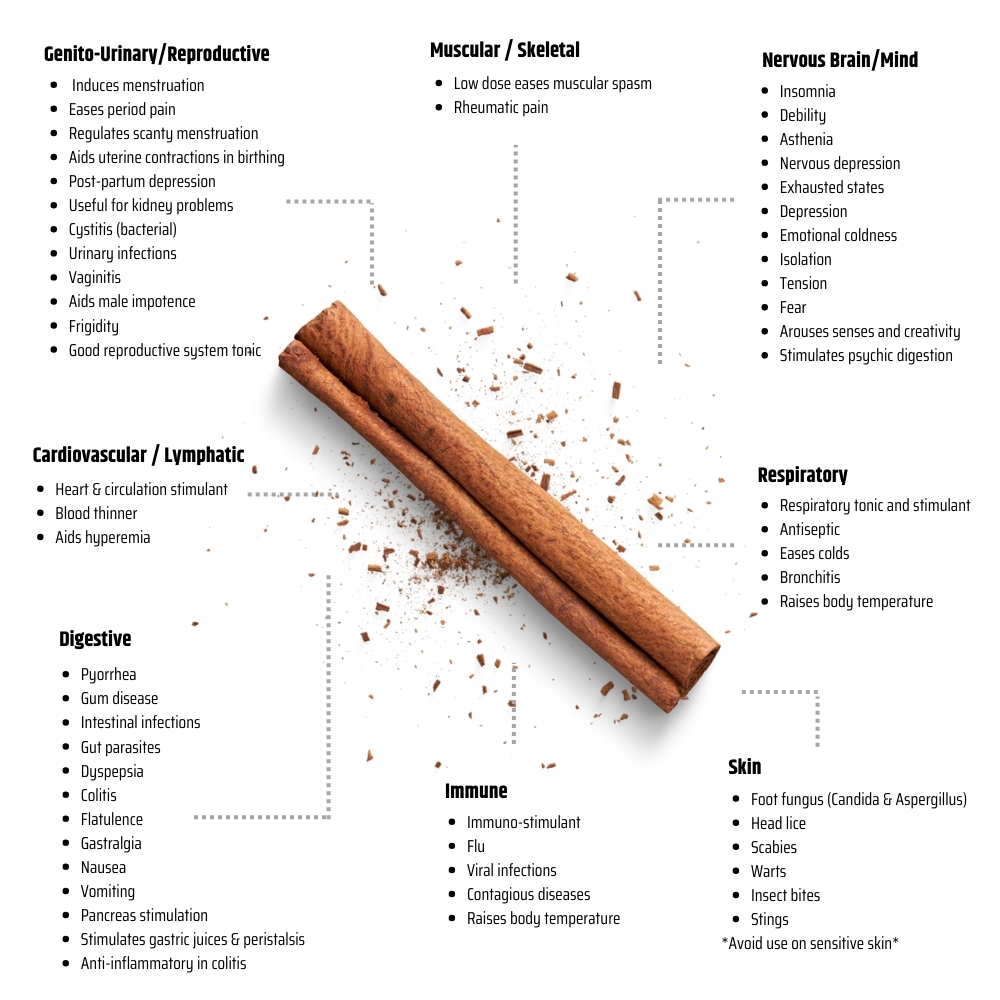
Australian Owned and Operated We have been proudly running for over 30 years

100% Pure & Natural Our products are sourced from the highest quality suppliers and growers from around the world

Not Tested on Animals None of our products are tested on animals

Vegan Friendly Our products are plant based and vegan friendly
Cinnamon Bark
Cinnamomum zeylanicum
Source: Whole Bark
Origin: Sri Lanka
Energetics: Yang
Extraction Method: Steam Distilled
Scent: Spicy, warm yet sweet. More spicy aroma as compared to cinnamon leaf oil.
Blends Well With: Benzoin, Bergamot, Cardamom, Clove, Frankincense, Ginger, Grapefruit, Mandarin, Marjoram, Peppermint, Vanilla and Ylang Ylang Complete.
About
In an Ayurvedic sense cinnamon bark is used for treating malaria, headache, bad breath, digestive disorders, sinus congestion, dyspepsia, blood circulation, scabies and intestinal infections. Vatha and Kapha- Pacifying.
Cinnamon bark oil is much higher in cinnamaldehyde than leaf oil.
Historical Snippets
Used as part of the embalming perfume of the Kings and Queens of Egypt. As an ingredient in anointing oil mixtures also and may have even been used on funeral pyres by ancient Romans. Eventually in more modern times this Sri Lankan spice travelled out from its homeland and its versatility shone through.
Key Constituents
- cadinene
- camphor
- cinnamaldehyde
- eugenol
How To Use
Diffuse: Add a few drops to a diffuser to disperse around the room
Topically: Dilute essential oil with any carrier oil at a 2.5% ratio. This equates to 2.5ml essential oil/oils in total mixed with 100ml of chosen carrier oil. 1ml of essential oil is approximately 20-22 drops of oil. Decant into a roller or glass bottle with eye dropper to apply easily or a larger bottle if using for massage. Please note this dilution rate is for adults and children over the age of 6. More information on children and essential oils is on our blog page. Essential Oils should not be used directly on the skin without mixing first with a carrier oil
Inhalation: Add 1-2 drops essential oil to a tissue and inhale at a distance while ensuring that the oil does not come into direct contact with the skin. Alternatively, you can smell the oil directly from the bottle.
Shelf Life
Our freshly decanted Cinnamon Bark essential oil will last for 3-4 years minimum from when you open your amber glass bottle if stored correctly.
Primary Storage Considerations: Keep away from direct light (U.V. radiation). Keep in the amber glass bottle with lid tightly closed. Only open when you need to and decant into a smaller "working" amber glass bottle if possible (and label so you know what is in it). This is to reduce oxidation.
Secondary Storage Considerations: Keep in a refrigerator at around 4 degrees celsius.
Safety
General
Some essential oils may cause photosensitivity to the skin - Use diluted in Jojoba or other complete carrier oil.
Do not ingest essential oils.
Do not apply to eyes, sensitive areas or mucous membranes.
The information on this website is not intended to be used in the diagnosis, treatment or mitigation of any physical or mental illness. Ahimsa Oils offer no advice or recommendations only general information. No therapeutic claims are made within.
Pregnant women, nursing mothers and children should not use essential oils without first consulting an appropriately trained healthcare practitioner.
The statements on this website have not been evaluated by the TGA. David Bosley however worked for a long period in consultation with the TGA to ensure correct labelling with reference to the Ahimsa Oil product range.
Specific
Hazards: Drug interaction; may inhbit blood clotting; embryotoxicity; skin sensitization (high risk); mucous membrane irritation (low risk)
Contraindications: Pregnancy, breastfeeding
Maximum dermal use: 0.07%
A dermal maximum of 0.7% is based on 75.7% cinnamaldehyde content with a dermal limit of 0.05%.
References
Sheppard-Hanger, Sylla. The Aromatherapy Practitioner Reference Manual: Atlantic Institute of Aromatherapy, 1999. Print.
Tisserand, R., & Young, R. (2014). Essential Oil Safety: Second edition.



 Available for $100 orders and over
Available for $100 orders and over

